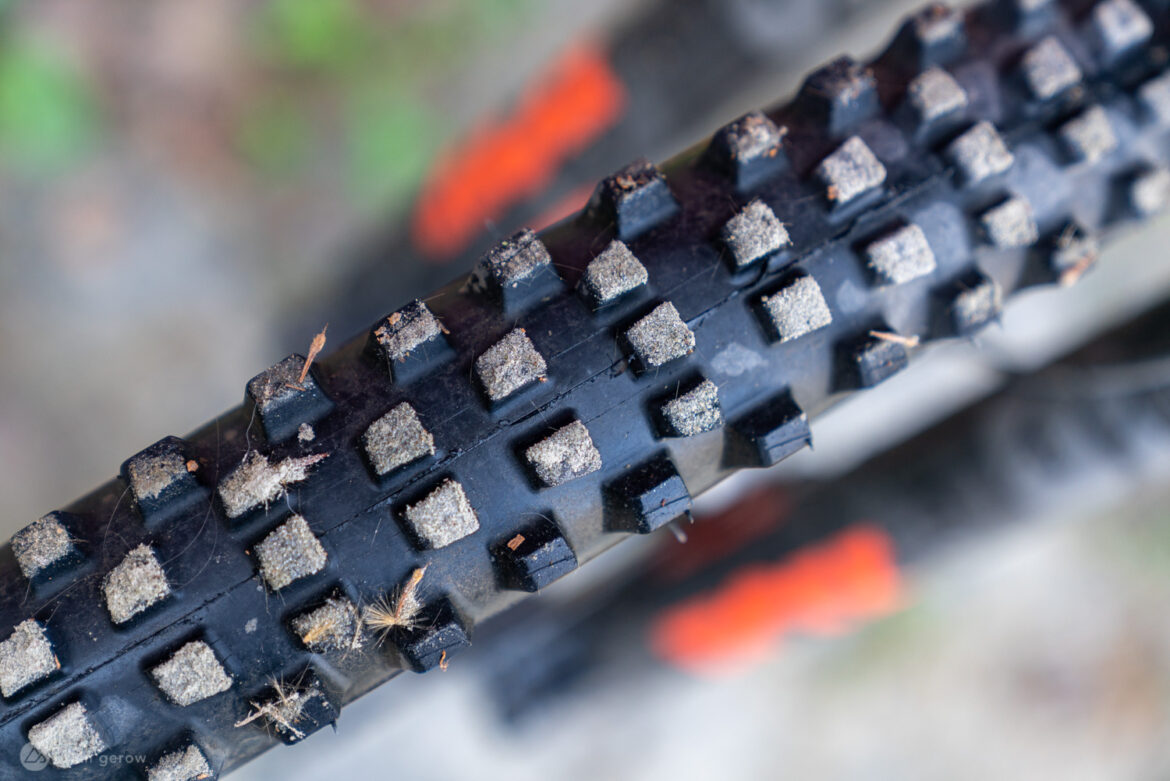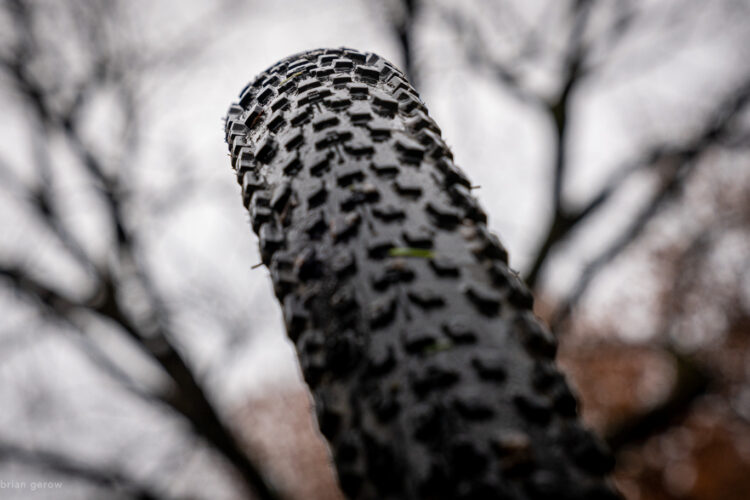
The new Michelin DH22 tires are the grippiest, fastest descending, most supportive, most robust, heaviest, hardest to set up tubeless, and hardest to pedal set of mtb tires I have ever ridden. That’s a load of mosts. We periodically review mountain bike components that can only be described with superlatives. As a writer, those less descriptive and more blunt-force terms are less than favorable. However, sometimes they’re necessary.
What are the Michelin DH22 tires for?
They are for downhill racers and mountain bikers who like to go to the bike park or shuttle bus for a full day of disregarding the brakes. While there are a number of EWS athletes racing on this new tread, I wouldn’t want to pedal these tires uphill for hours if there was a lighter option.
What I want to do doesn’t always factor into testing. I climbed for more hours than I care to admit aboard these DH tires, feeling like my rear brake was dragging all the way up. On one four-hour pedal, I started bonking half way through and pulled over to check that my brake calipers weren’t misaligned a few times, which doubled as an excuse to pause for a rest.
The Michelin DH22 tires gummy grip and puncture-proofing qualities are designed 100% for downhill racing, and it’s clear that the engineers at Michelin didn’t think once about climbing on these 1,500g tires. That’s right, the 29 x 2.4″ pair weighs 3,000g (6.61lbs). The only people racing six-hour enduro events on these are hero-level fit athletes.


Downhill Speed and Grip of the Michelin DH22 Tires
Enough about what these Michelin mtb tires are not made to do. On the way back downhill I managed to scare myself with the amount of speed and lean I could achieve aboard the Michelin DH22 tires. The widely spaced tread grips every surface better than any other gravity tire I’ve tested, and I’ve tested a truckload of them. From hardpacked clay to wet roots, the tread clings to anything, allowing the pilot to take faster and riskier lines to shave seconds off a run.
The lugs don’t require any fancy siping to achieve that grip. They simply use ultra soft rubber that makes rock climbing shoe soles feel tough. Unlike the Michelin Wild Enduro tread, the Michelin DH22 tire knobs don’t line up all the way across the tire as one solid force. The two center tread bits alternate between a narrower pairing and a more separated configuration, and the shoulder lugs are spaced in line with the gaps of those central lugs, creating a clean transition between the rows while maintaining ample mud-clearing gaps.

I rode with these tires at Pila Bike Park in Valle D’Aosta a few times and blew my former descent times away by wide margins. The heavy-handed grip that the tread creates on bermed and flat corners is unprecedented. That same gummy goodness that makes them feel terrible on the climb puts them at the top of the gravity-grip pile. With 20PSI up front and about 24PSI in the rear, the tread and carcass didn’t squirm a bit, no matter how hard I pushed them into rough and loose earth.
On to the carcass. The 2-ply 55TPI casing is one of the most rigid I have seen. With its tubeless wire bead, the Michelin DH22 stands perfectly round and tall when you lean the unmounted tire against a wall. That thick casing is designed to provide maximum puncture protection and cornering stability, and it does both of those things with aplomb.
I rode the IXS downhill course at Pila, and clanged my rim against a baker’s dozen rocks without a puncture — despite not having an insert in the rear tire. Deep in banked turns and harder compressions the casing holds up forcefully, and allowed me to push the bike harder into the turn without any concern that the sidewalls would flex or fold.

Michelin DH22 Tubeless Setup
Downhillers and park partiers will want to use a powerful air compressor to set these Michelin DH tires up tubeless. Their rigid sidewalls make it tricky to get the bead to seat, and the extra air pressure will help.
I have a Bontrager Flash Charger pump that has seated hundreds of tires without issue, but it couldn’t make these budge. I had to use a friend’s compressor, and that alone wasn’t enough. We had to go the old-school tubeless route, mounting the bead with a tube first, then gently removing the bead on one side to take the tube out and add the valve and sealant. With one bead mounted the tire popped right into place, and it has stayed put since.

While the casing of these Michelin DH tires will likely last a lifetime, the tread will not. The soft compound loses a lot of material to gain all of that grip, and the tradeoff is that these tires will likely not roll through a full season. They are a good candidate for regular rotation. Once the rear tire wears thin, rotate the front mtb tire to the rear and then replace the front.
Michelin says that the DH22 tire is best for hard packed to loose conditions, while their new DH34 tire offers a faster rolling tread pattern, and the DH Mud takes care of the sloppier stuff. There is also a Michelin DH34 Bike Park version that’s about 100g lighter, with a slightly harder rubber compound to last through the summer.
- Price: $100
- Available at Amazon and other retailers





















11 Comments
Jul 12, 2020
I have a few questions regarding these tyres. What is the internal width of the rim you used with them? Do you know what internal rim width Michelin designed them for? Were you using tyre inserts?
I'd greatly appreciate your feedback
Jul 27, 2020
Thanks for sharing Michelin's response. Interesting to hear 28 mm, presumably developed on a Mavic Deemax. Will give them a go, hopefully the profile doesn't become too square on a 33 mm rim width
Jul 24, 2020
This is the official answer from Michelin.
"The DH22 was developed on a 28mm rim. However, due to multiple variables including a rider’s set up, rim brand, etc., Michelin does not offer an official recommendation."
Jul 13, 2020
I will let you know as soon as I find anything on internal rim width, from Michelin or otherwise. I'd put my money on 33mm being a great fit. It's such a small difference, and these already feel superb.
They do inflate to 2.4" almost spot on. I believe the caliper measurement was less than a millimeter difference.
If I were racing to win DH events, or trying to win an enduro on these, I might throw an insert in the rear. Just for peace of mind. Apart from those rare cases, the casing will do the job handily.
It sounds like you read the review, and might be on the fence about buying a set. If you really only care about descending grip and riding as fast as possible with gravity, I say give them a shot. These tires will impress you when it gets steep and dicey.
-Gerow
Jul 13, 2020
Thanks
Chris
Jul 13, 2020
The internal width of my rims is 30mm, though I'm not sure what the recommended width is. I'll ask Michelin and get back to you if they reply. The tires only come in 2.4" sizes, so there's a good chance they only tested them on rims with 30mm internal widths.
I didn't put an insert in since it was already exceedingly difficult to get these to set up tubeless. Also, i wanted to really slap the casing into some rocks and see how it held up. I am currently riding them in the Alps on some of the roughest trails in Europe, with zero punctures.
Best,
Gerow
Jul 27, 2020
My favourites are the Maxis High Roller 2 DD They last about a 1000 KM where I ride, they plow through the spring time mud really well and they climb a really steep rocky hill like mad. They are super in fast slick corners.
Jul 14, 2020
Jul 23, 2020
Can you share what tires work best on your local trails? Where do you ride most, and what's giving you the best grip on the slippery stuff?
Jul 14, 2020
Jul 14, 2020
On your other comment: We don't get paid by any of the companies that we write reviews of for. Fortunately, there is no way to buy a good review. I simply write my experience and analysis of the product with the hope that it will help folx narrow down their choices.